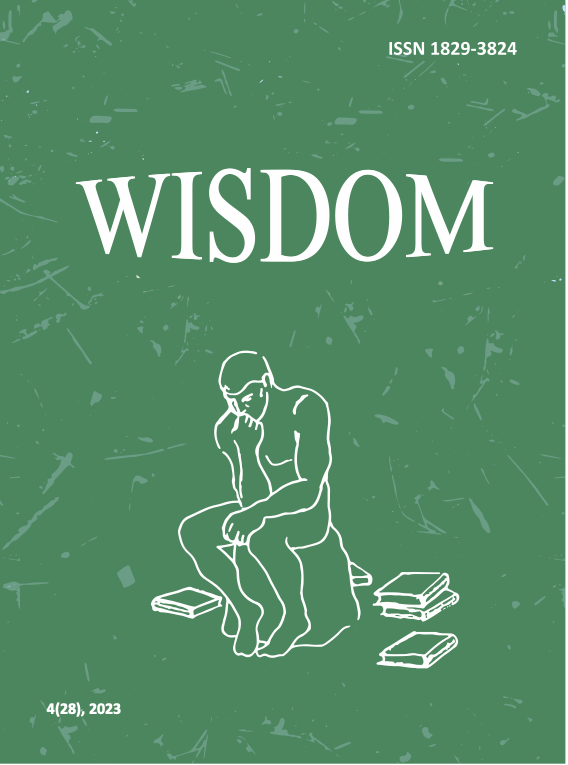Communication Noise as a Discourse Component
DOI:
https://doi.org/10.24234/wisdom.v14i1.325Keywords:
communication, discourse, communication noise, barrier, vagueness, ambiguityAbstract
The paper focuses on the investigation of communicative noise at various levels of monocultural and intercultural communication. Communication noise is seen as a component of a communicative event, functioning as obstacles of different nature that lower the effectiveness of communication, destabilize it and are able to cause communicative conflict or the breakdown of communication. In linguistic pragmatics the main features of communication noise have been identified as vagueness and ambiguity of a message: vagueness is characterized by a bigger degree of noise than ambiguity. The authors of the article have tried to probe more deeply into the area of communication noise by singling out levels of communicative situation. The article offers a differentiation of five discourse levels: verbal-semiotic, cognitive-interpretational, interactive, ontological and sociocultural levels. The main part of the paper analyzes the barriers that cause communication noise at each of the offered levels of communicative situation. The raised issues offer prospects for further research, such as investigating of noise effects in real communication, identifying a set of causes leading to communication noise, as well as noise-resistant factors, preventing or removing it.
Downloads
References
Beaton, M.C. (2009). Agatha Raisin and the Day the Floods Came. London : C & R Crime.
Beaton, M.C. (1997). Agatha Raisin and the Terrible Tourist. London : St. Martin’s Press.
Beaton, M.C. (1999). Agatha Raisin and the Wizard of Evesham. London : St. Martin’s Press.
Beaton, M.C. (1987). Death of a Cad. London: St. Martin’s Press.
Beaton, M.C. (2001). Death of a Dustman. London : Mysterious Press.
Beaton, M.C. (2011). Death of a Perfect Wife. London : C & R Crime.
Clyne, М. (1994). Inter-cultural Communication at Work : Cultural Values in Discourse. Cambridge : CUP.
Doyle, A.C. (2019). The complete Sherlock Holmes. London : Chartwell Books. DOI: https://doi.org/10.7208/chicago/9780226659787.001.0001
Eko, U. (1998). Otsutstvuyuschaya struktura. Vvedenie v semiologiyu (Absent structure, introduction to semiology, in Russian). Moscow : Petropolis.
Eco, U. (1989). The Open Work. Massachusetts : Harvard University Press.
Etnopsiholingvistika (Ethnic-psycholinguistics, in Russian). (1988). Moscow : Nauka.
Fillmore, C. (1982). Frame semantics. Linguistics in the morning calm, 111–137
Frumkina, R.M. (1995). Pragmatika: novyiy vzglyad (Pragmatics : a new overlook, in Russian). Semiotics and informatics. Issue 34. Moscow, 98 – 113.
Goldiamond, I., & Hawkins, W. F. (1958). Vexierversuch: The log relationship between word-frequency and recognition obtained in the absence of stimulus words. Journal of Experimental Psychology, 56(6), 457-463. DOI: https://doi.org/10.1037/h0043051
Grice, H.P. (1991). Logic and conversation. Studies in the way of words. N.Y. : Academic Press, 22-40.
Haddon, M. (2012). The Curious Incident of the Dog in the Night-time. London : Vintage Digital.
Kinsella, S. (2003). Can You Keep a Secret? London : Black Swan.
Kluckhohn, C. (1949). Mirror for Man. New York : Fawcett.
Lakoff, G. (1987). Women, Fire and Dangerous Things. Chicago : The University of Chicago Press. DOI: https://doi.org/10.7208/chicago/9780226471013.001.0001
Leech, G. (1981). Semantics. London : Penguin Books.
Leontev, A.A. (1999). Osnovyi psiholingvistiki (The basis for psycholinguistics, in Russian). Moscow : Smyisl.
Martin, R.C., & Freedman, M.L. (2001). Short-term retention of lexical-semantic representations : Implications for speech production. Memory, 9 (4/5/6), 261–280. DOI: https://doi.org/10.1080/09658210143000173
Oliinyk, G.O. (2019). Verbalni ta neverbalni zasoby vyrazhennia nerozuminnia v suchasnomu anhlomovnomu literaturnomu ta kinodyskursi: kohnityvno-prahmatychne doslidzhennia (Verbal and nonverbal communicative means of expressing misunderstanding in modern English literary and film discourse: cognitive pragmatic research, in Ukrainian): Thesis for the candidate degree in philology. Speciality 10.02.04 – Germanic languages. Odessa : Odesa I.I. Mechnikov National University.
Rechevyie priemyi i oshibki: Tipologiya, derivatsiya, funktsionirovanie (1989). (Speech methods and mistakes : Typology, derivation, functioning, in Russian). Moscow : Prosveschenie.
Rothwell, D. J. (2004). In the Company of Others : An Introduction to Communication. New York: McGraw Hill.
Shannon, C.E., & Weaver, W. (1949). The Mathematical Theory of Communication. Urbana, IL : University of Illinois Press.
Shklovsky, V. (1990). Theory of Prose. Translated by B. Sher. Dalkey Archive Press.
Selivanova, Y.A. (2000). Lingvokulturnyiy aspekt kommunikativnogo shuma (Linguocultural aspect of communication noise, in Russian). International Scientific Conference LINGVAPAX 8. Kiev : UNESCO, KSLU. Vol. 3, 51-56.
Selivanova, O.O. (2010). Linhvistychna entsyklopediia (Linguistic encyclopedia, in Ukrainian). Poltava : Dovkillia-K.
Smith, Z. (2001). White teeth. London : Penguin.
Sorokin, Yu.A., & Markovina, I.Yu. (1983). Opyit sistematizatsii lingvisticheskih i kulturologicheskih lakun (Experience of systematization of linguistic and culturological lacunes, in Russian). Lexical units and organization of text structure. Kalinin : Kalinin State University, 215 – 257.
Susov, I.P. (1988). Deyatelnost, soznanie, diskurs i yazyikovaya shema (Activity, conscience, discourse, and language scheme, in Russian). Speech communication : Processes and units. Kalinin : Kalinin State University, 7-13.
Tarasova, E.V. (2000). Rechevaya sistemnost v terminah (Speech systematization in terms, in Russian). The Journal of V. N. Karazin Kharkiv National University. Kharkiv. № 471, 276-283.
Trollope, J. (2010). The Other Family. New York : Transworld Digital.
Twain, M. (2012). The Adventures of Tom Sawyer. London : Vintage Digital.
Uhtomskiy, A.A. (1950). Sobranie sochineniy (Complete works, in Russian). Leningrad. V. 1.
Waugh, E. (2012). Vile Bodies. New York : Hachette.
Wilde, O. (2002). The Importance of Being Earnest. London : Penguin Books.
Wodehouse, P.G. (2009). Jeeves in the Offing. New York : Cornerstone Digital.
Wodehouse, P.G. (2004). Much Obliged, Jeeves. New York : Everyman.
Wodehouse, P.G. (2015). Right Ho, Jeeves. London : Otbebookpublishing.
Yakobson, R. (1975). Lingvistika i poetika (Linguistics and poetics, in Russian). Structuralism : “for” and “against”, 193-230.
Downloads
Published
How to Cite
Issue
Section
License
Creative Commons Attribution-Non-Commercial (CC BY-NC). CC BY-NC allows users to copy and distribute the article, provided this is not done for commercial purposes. The users may adapt – remix, transform, and build upon the material giving appropriate credit, and providing a link to the license. The full details of the license are available at https://creativecommons.org/licenses/by-nc/4.0/.















